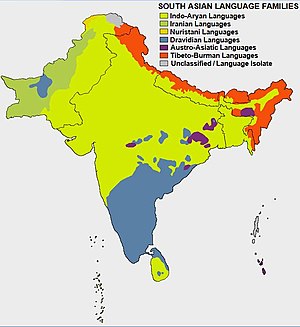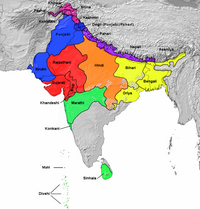South Asian ethnic groups
South Asian ethnic groups are an ethnolinguistic grouping of the diverse populations of South Asia, including the nations of India, Pakistan, Bangladesh, Nepal, Bhutan, the Maldives and Sri Lanka.[1] While Afghanistan is variously considered to be part of both Central Asia and South Asia, Afghans are generally not included among South Asians.[2][3][4][5][6]
The majority of the population fall within three large linguistic groups: Indo-Aryan, Dravidian and Iranic. The Indian, Nepalese and Sri Lankan societies are traditionally divided into castes or clans, which are based primarily on labour divisions; these categories have had no official status in India since independence in 1947, except for the scheduled castes and tribes, which remain registered for the purpose of affirmative action. In today's India, the population is categorised in terms of the 1,652 mother tongues spoken.
These groups are also further subdivided into numerous sub-groups, castes and tribes. Indo-Aryans form the predominant ethno-linguistic group in India (North India, East India, West India, Central India), Bangladesh, Pakistan, Nepal, Sri Lanka and the Maldives.[7] Dravidians form the predominant ethno-linguistic group in southern India, the northern and eastern regions of Sri Lanka and a small pocket of Pakistan.[8] The Iranic peoples also have a significant presence in South Asia, the large majority of whom are located in Pakistan.[9][10]
Minority groups not falling within either large group mostly speak languages belonging to the Austroasiatic and Tibeto-Burman language families, and largely live around Ladakh and Northeast India, Nepal, Bhutan and the Chittagong Hill Tracts of Bangladesh. The Andamanese (Sentinel, Onge, Jarawa, Great Andamanese) live in some of the Andaman Islands and speak a language isolate, as do the Kusunda in central Nepal,[11] the Vedda in Sri Lanka, and the Nihali of central India, who number about 5,000 people. The people of the Hunza valley in Pakistan are another distinct population; they speak Burushaski, a language isolate.
The traditions of different ethnic groups in South Asia have diverged, influenced by external cultures, especially in the northwestern parts of South Asia and also in the border regions and busy ports, where there are greater levels of contact with external cultures. There is also a lot of genetic diversity within the region. For example, most of the ethnic groups of the northeastern parts of South Asia are genetically related to peoples of East or Southeast Asia. There are also genetically isolated groups who have not been genetically influenced by other groups, such as the Jarawa people of the Andaman Islands. The largest ethno-linguistic group in South Asia are the Indo-Aryans, numbering around 1 billion, and the largest sub-group are the native speakers of Hindi languages, numbering more than 470 million.
These groups are based solely on a linguistic basis and not on a genetic basis.
List of ethnic groups on the basis of language
Indo-Aryan people
- Assamese people[12]
- Awadhi people
- Banjara people
- Bhojpuri people
- Bengali people
- Bhil people
- Chakma
- Chitrali people
- Deccani people
- Dhivehi people
- Dogra people
- Garhwali people
- Gujarati people
- Haryanvi people
- Kalash people
- Kamrupi people
- Kashmiri people
- Khas people
- Konkani people
- Kumaoni people
- Kutchi people
- Maithili people
- Maldivian people
- Marathi people
- Magahi people
- Meena people
- Muhajir people
- Nagpuria people
- Odia people
- Pahari people
- Punjabi people
- Rajasthani people
- Rohingya people
- Sindhi people
- Saraiki people
- Saurashtra people
- Sinhalese people
- Shina people
- Sylheti people
- Tanchangya people
- Tharu
- Urdu-speaking people
Iranic people
Nuristani people
Dravidian people
- Badagas
- Brahui people
- Dongria Kondha
- Gondi people
- Irulas
- Kannadigas
- Khonds
- Kodava
- Kurukh/Oraon
- Malayali
- Malto people
- Sauria Paharia people
- Tamil people
- Telugu people
- Toda people
- Tuluvas
Austroasiatic people
Tibeto-Burmese people
- Tibetans and Tibetan-speaking peoples
- Bodo-Kachari people
- Chepang
- Gurung
- Khowa
- Kirati people
- Lepcha people
- Magar people
- Memba
- Naga people
- Anāl Naga
- Angami Naga
- Ao Naga
- Chakhesang Naga
- Chang Naga
- Chiru Naga
- Chothe Naga
- Khiamniungan Naga
- Konyak Naga
- Lainong Naga
- Lamkang Naga
- Lotha Naga
- Mao Naga
- Maram Naga
- Maring Naga
- Monsang Naga
- Moyon Naga
- Nocte Naga
- Para Naga
- Poumai Naga
- Phom Naga
- Pochury Naga
- Rengma Naga
- Sangtam Naga
- Sümi Naga
- Tangkhul Naga
- Tangsa Naga
- Tarao Naga
- Thangal Naga
- Tikhir Naga
- Tutsa Naga
- Wancho Naga
- Yimkhiung Naga
- Zeliangrong
- Newar people
- Nishi
- Tamang
- Thakali
- Tripuri
- Meitei (Manipuri)
- Karbi people or Mikir
- Thami
- Zo people
Andamanese and Nicobarese groups
- Great Andamanese of the Andaman and Nicobar Islands
- Jangil of the Andaman and Nicobar Islands
- Jarawa of the Andaman and Nicobar Islands
- Onge of the Andaman and Nicobar Islands
- Sentinelese of the Andaman and Nicobar Islands
Semitic people
- Arabs or mixed Arab and Indo-Aryan or Dravidian
- Arabs in Gujarat
- Sri Lankan Moors (trace ancestry to Arab traders who settled in Sri Lanka)
- Iraqi biradri - a community of Muslims in north India (trace ancestry from Arab tribe of Bani Tamim)
- Labbay Arab traders who settled in South India
- Konkani Muslims trace their ancestry to Arab traders.
- Mappila Muslims trace their ancestry to Arab traders.
- Boras trace ancestors to Arab traders and merchants.
- Chaush trace ancestors to traders from Yemen.
- Syrian Malabar Nasranis are descendants of both Brahmin, Nair and Jewish converts to Christianity. (Some mixed later with Persians and Europeans later on)[citation needed]
- Knanaya Syriac Christians who trace their origins to Mesopotamia
- Indian Jews
- Cochin Jews (Malayali Jews)
- Bene Israel (Marathi Jews)
- Baghdadi Jews (Arab Jews in Bengal)
- Bnei Menashe (Mizo and Kuki Jews)
- Bene Ephraim (Telugu Jews)
- Paradesi Jews (European Jews in India)
Tai people
- Ahom people
- Tai Aiton
- Tai Phake or Tai Phakial
Turkic peoples
- Turkish Indian
- Rowther are alleged descendants of Seljuk Turks in Turko-Persian tradition. They have since become the tradition of Turko-Indian in 12th Century.
- Mughal (Moghul) (A Sunni Islamic dynasty of Asia which originated in Central Asia)
- Chughtai Tartars (Those people who originated in Uzbekistan and fought for Chagatai Khan who was son of Genghis Khan).
- Barlas (A Turkified Mongol tribe to which Babur belonged)
- Changezi (Those who were in army of Hulagu Khan)
Afro-Asian groups
- Chaush
- Sheedis/Siddis, an ethnic community of Black African descent, found primarily in Pakistan, Gujarat, and Karnataka.
- Sri Lanka Kaffirs
European and Eurasian people
- Anglo-Burmese
- Anglo-Indian
- Bangladeshi-Armenians
- Burgher people
- French-Indian
- Luso-Indian
- Romani people
- Eurasians
Austronesian people
East Asian people
Chinese
Linguistically isolate groups
Diaspora
Many South Asian ethnic groups and nationalities have substantial diasporas outside of South Asia.
- South Asian American
- South Asian Canadian
- British Asian
- South Asian Australian
- Indo Kiwi
- Indians in Singapore
- Malaysian Indian
- Nepalis in Singapore
- Nepalese people in Malaysia
- Indian Indonesian
- Indo-Mauritian
- Indo-Caribbean
- Indians in South America
- Burmese Indians
- South Asians in Hong Kong
- South Asians in the Philippines
- Indians in Germany
- Nepalis in Germany
- Indian South Africans
- Indians in Botswana
- Indians in Kenya
- Indians in Madagascar
- Indo-Mauritian
- Indians in Mozambique
- Indo-Réunionnaise
- Indo-Seychellois
- Indians in Tanzania
- Indians in Uganda
- Indians in Zambia
- Indians in Zimbabwe
- Indians in Iran
- Indians in Thailand
- Indians in the United Arab Emirates
- Indians in Vietnam
- Indians in Panama
- Indian diaspora in France
- Indians in Israel
- Indians in Italy
- Indians in Portugal
- Indian community in Spain
- Indo-Fijian
- Indians in New Caledonia
See also Bangladeshi diaspora, Indian diaspora, Nepalese diaspora, Pakistani diaspora, Punjabi diaspora, Sri Lankan Tamil diaspora, Tamil diaspora.
Two (or possibly three) other people groups have ethnic and linguistic ties with the region:
- Dom people
- Romani people
- Lom people (who speak a language both related to Indo-Aryan and Armenian)
See also
- Languages of South Asia
- Languages of Bangladesh
- Languages of Bhutan
- Languages of India
- Languages of Maldives
- Languages of Nepal
- Languages of Pakistan
- Languages of Sri Lanka
- List of ethnolinguistic regions of South Asia
- List of indigenous peoples of South Asia
- List of Scheduled Tribes in India
- Scheduled Castes and Scheduled Tribes
- Non-resident Indian and person of Indian origin
- Non Resident Nepali
- Overseas Pakistani
- Desi
- Ethnic groups in Pakistan
- Ethnic groups in Nepal
- Genetics and archaeogenetics of South Asia
- Y-DNA haplogroups in populations of South Asia
National demographics:
- Demographics of Bangladesh
- Demographics of Bhutan
- Demographics of India
- Demographics of the Maldives
- Demographics of Nepal
- Demographics of Pakistan
- Demographics of Sri Lanka
References
- ^ "UN Geoscheme".
- ^ Danico, Mary Yu (2014). Asian American Society: An Encyclopedia. SAGE Publications. p. 838. ISBN 978-1-4522-8189-6.
- ^ Bhopal, Raj (2004). "Glossary of terms relating to ethnicity and race: for reflection and debate". Journal of Epidemiology & Community Health. 58 (6): 441–445. doi:10.1136/jech.2003.013466. PMC 1732794. PMID 15143107.
- ^ "Language and the BSA: Ethnicity & Race". British Sociological Association. March 2005. Archived from the original on 27 April 2015. Retrieved 27 April 2015.
- ^ Sarwal, Amit (2012). Bridging Imaginations: South Asian Diaspora in Australia. Readworthy Publications. ISBN 978-81-935345-4-0.
- ^ Lindsay, olin (2001). "The South Asian Community" (PDF). Profiles of Ethnic Communities in Canada. Ottawa: Statistics Canada. Archived from the original (PDF) on 23 June 2013. Retrieved 9 November 2014.
- ^ Chitta, Sridhar (7 January 2022). The Knowledge in the Vedas. StoryMirror Infotech Pvt Ltd. p. 173. ISBN 978-93-92661-61-7.
- ^ Swan, Michael; Smith, Bernard (26 April 2001). Learner English: A Teacher's Guide to Interference and Other Problems. Cambridge University Press. p. 227. ISBN 978-0-521-77939-5. Retrieved 18 October 2016.
- ^ Kachru, Braj B.; Kachru, Yamuna; Sridhar, S. N. (27 March 2008). Language in South Asia. Cambridge University Press. p. 34. ISBN 978-1-139-46550-2.
- ^ "Pakistan", The World Factbook, Central Intelligence Agency
- ^ D.E. Watters, Notes on Kusunda (a language isolate of Nepal), Kathmandu 2005
- ^ Yasmin Saikia (9 November 2004). Fragmented Memories. ISBN 0822333732.
External links
![]() Media related to Ethnic groups in India at Wikimedia Commons
Media related to Ethnic groups in India at Wikimedia Commons
![]() Media related to Ethnic groups in Pakistan at Wikimedia Commons
Media related to Ethnic groups in Pakistan at Wikimedia Commons
![]() Media related to Ethnic groups in Nepal at Wikimedia Commons
Media related to Ethnic groups in Nepal at Wikimedia Commons
BoilerPlate was here

